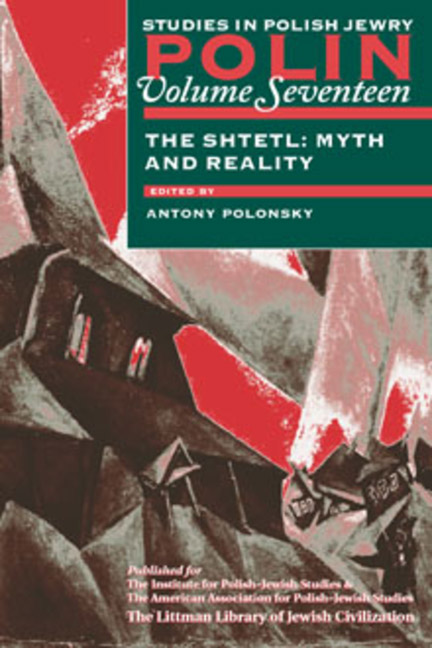Book contents
- Frontmatter
- Dedication
- Editors and Advisers
- Preface
- Polin
- Polin: Studies inPolish Jewry
- Contents
- Note on Place Names
- Note on Transliteration
- List of Abbreviations
- PART I THE SHTETL: MYTH AND REALITY
- Introduction. The Shtetl: Myth and Reality
- The Shtetl as an Arena for Polish–Jewish Integration in the Eighteenth Century
- Inter-Religious Contacts in the Shtetl: Proposals for Future Research
- The Hasidic Conquest of Small-Town Central Poland, 1754–1818
- The Drama of Berdichev: Levi Yitshak and his Town
- Polish Shtetls under Russian Rule, 1772–1914
- How Jewish Was the Shtetl?
- The Changing Shtetl in the Kingdom of Poland during the First World War
- The Shtetl: Cultural Evolution in Small Jewish Towns
- Small Towns in Inter-War Poland
- Jewish Patrons and Polish Clients: Patronage in a Small Galician Town
- Maintaining Borders, Crossing Borders: Social Relationships in the Shtetl
- The Soviet Shtetl in the 1920s
- Shtetl and Shtot in Yiddish Haskalah Drama
- Kazimierz on the Vistula: Polish Literary Portrayals of the Shtetl
- Imagining the Image: Interpretations of the Shtetl in Yiddish Literary Criticism
- Shtetl Codes: Fantasy in the Fiction of Asch, Schulz, and I. B. Singer
- Returning to the Shtetl: Differing Perceptions
- PART II NEW VIEWS
- PART III DOCUMENTS
- PART IV THE SIXTY-FIFTH ANNIVERSARY OF EVENTS IN PRZYTYK: A DEBATE
- PART V REVIEWS
- OBITUARIES
- Notes on the Contributors
- Glossary
- Index
Polish Shtetls under Russian Rule, 1772–1914
from PART I - THE SHTETL: MYTH AND REALITY
- Frontmatter
- Dedication
- Editors and Advisers
- Preface
- Polin
- Polin: Studies inPolish Jewry
- Contents
- Note on Place Names
- Note on Transliteration
- List of Abbreviations
- PART I THE SHTETL: MYTH AND REALITY
- Introduction. The Shtetl: Myth and Reality
- The Shtetl as an Arena for Polish–Jewish Integration in the Eighteenth Century
- Inter-Religious Contacts in the Shtetl: Proposals for Future Research
- The Hasidic Conquest of Small-Town Central Poland, 1754–1818
- The Drama of Berdichev: Levi Yitshak and his Town
- Polish Shtetls under Russian Rule, 1772–1914
- How Jewish Was the Shtetl?
- The Changing Shtetl in the Kingdom of Poland during the First World War
- The Shtetl: Cultural Evolution in Small Jewish Towns
- Small Towns in Inter-War Poland
- Jewish Patrons and Polish Clients: Patronage in a Small Galician Town
- Maintaining Borders, Crossing Borders: Social Relationships in the Shtetl
- The Soviet Shtetl in the 1920s
- Shtetl and Shtot in Yiddish Haskalah Drama
- Kazimierz on the Vistula: Polish Literary Portrayals of the Shtetl
- Imagining the Image: Interpretations of the Shtetl in Yiddish Literary Criticism
- Shtetl Codes: Fantasy in the Fiction of Asch, Schulz, and I. B. Singer
- Returning to the Shtetl: Differing Perceptions
- PART II NEW VIEWS
- PART III DOCUMENTS
- PART IV THE SIXTY-FIFTH ANNIVERSARY OF EVENTS IN PRZYTYK: A DEBATE
- PART V REVIEWS
- OBITUARIES
- Notes on the Contributors
- Glossary
- Index
Summary
ON 24 Heshvan 5561 (11 November 1800), the parnasim, or communal elders, of the Minsk kahal voted to send a delegation to Vitebsk ‘to see how things are done there’. At first, this may appear a curious decision. What could the Jews of Minsk, a large and respected community, learn from their ‘little brothers’ in Vitebsk? The answer has to do with chronology: since 1772 Vitebsk had been under the power of Russia, serving as a laboratory for the implementation of policies designed to regulate a newly acquired Jewish minority for whom there were no existing legal provisions. Russian policy had brought Belarusian Jewry greater statutory rights than any other contemporary Jewish community in Europe. The Jewish denizens of Minsk, having fallen under Russian control only in 1793, wished to learn how to deal with their new rulers.
This incident may serve as a salient reminder that the Jews of the Russian empire were in fact Polish Jews—or, more accurately, subjects of the Polish–Lithuanian Commonwealth, the state that was devoured by Russia, Prussia, and the Habsburg empire in the last quarter of the eighteenth century. As its name implied, the Commonwealth was a multi-ethnic state, inhabited by peoples of diverse ethnicities, religions, and traditions. Even the Jews of the Commonwealth were a diverse lot: there were mitnagedim, hasidim, Karaites, and even a few maskilim—as the partisans of the Jewish Enlightenment movement, the Haskalah, were known. The Yiddish that they spoke was not uniform across regions. Their political traditions differed, especially between the Jews of the Polish ethnic heartland and those of the Grand Duchy of Lithuania. Nor were political boundaries a bar to communications across frontiers; the boundaries between the lands of (Russian) Ukraine and (Austrian) Galicia were especially porous.
In response to the question ‘did Russian Jewry exist prior to 1917?’, Eli Lederhendler has answered in the affirmative. He has argued that the factors uniting the Jews of the empire were greater than those dividing them. One may accept Lederhendler's assessment with one major caveat: we must differentiate clearly between Jews in the provinces of the Pale of Settlement and Jews in the Kingdom of Poland.
- Type
- Chapter
- Information
- The Shtetl: Myth and Reality , pp. 97 - 108Publisher: Liverpool University PressPrint publication year: 2004



